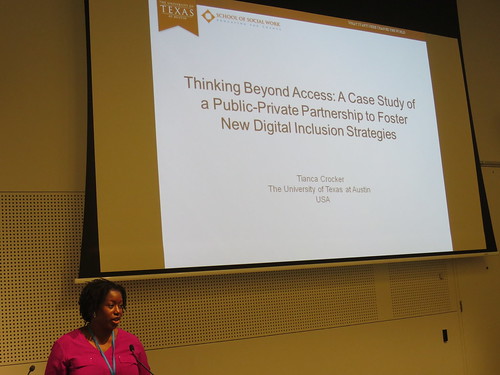Paper presented at #husITa14 in Melbourne, Australia, July 2014.
Presenters
Tianca Crocker (University of Texas at Austin, USA).
Abstract
In today’s increasingly digital-by-default societies, Google is as indistinguishable from the Internet as Kleenex is to facial tissues. A recent announcement by the prominent information technology company confirmed intentions to build a remarkably high-speed broadband Internet network known as ‘Google Fiber’ in Austin, Texas, the second of only three pilot cities in the United States (USA). This presentation focuses on Community Connections, a digital inclusion component of the venture between the City of Austin and Google Fiber to provide ten years of no-cost broadband Internet services to a strategically selected number of public and not-for-profit organizations with aspirations of implementing sustainable community projects. This presentation addresses questions of:
- What are the persistent and evolving drivers of digital exclusion in a technology-dominated region?
- What lessons can social workers, human service organizations and municipalities learn from this public-private partnership to promote digital inclusion during a period of public finance restraint?
- What are the most salient inclusion strategies found in counterpart and developing societies?
Local research shows that City of Austin residents access the Internet at home at a higher rate than the national USA average, yet disparities in access and civically-motivated use (i.e. health promotion, education, news, employment services, etc.) persist among people from low-income backgrounds, Hispanics, African Americans, and recent immigrants. The perception of digital inclusion is evolving with emergent technologies to encompass greater improvements related to Internet functionality and support for wireless Internet networks that circumvent infrastructure and cost barriers to access. This presentation explores these questions through a case study analysis of the Community Connections’ ongoing selection process with respect to the advancement of individual wellbeing and economic mobility. The presentation will reference several artifacts including municipal documents, spatial analysis, media reports, peer-reviewed research and stakeholder interviews.
Comments Please use the reply section below to comment and discuss this paper.
Back to programme

